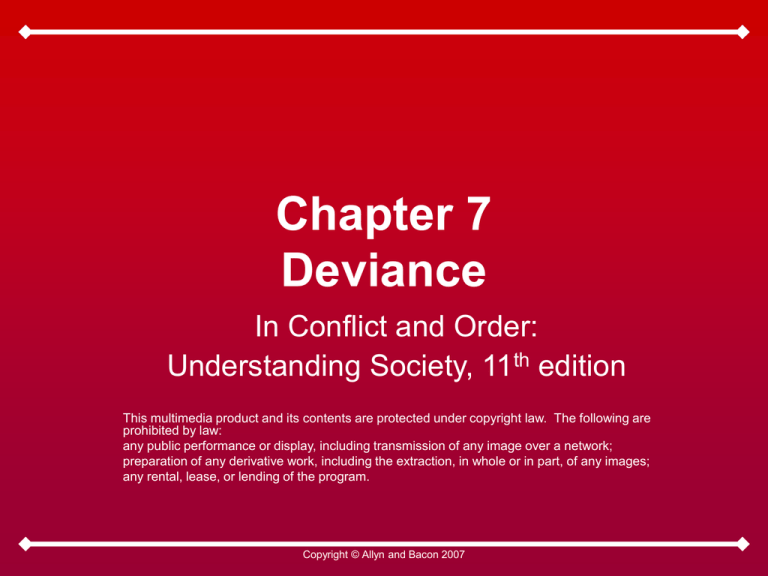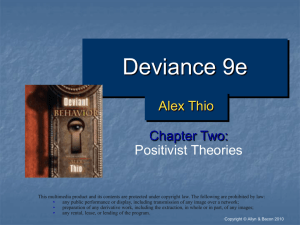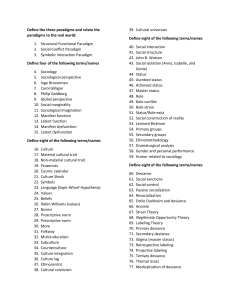Chapter 7 Deviance
advertisement

Chapter 7 Deviance In Conflict and Order: Understanding Society, 11th edition This multimedia product and its contents are protected under copyright law. The following are prohibited by law: any public performance or display, including transmission of any image over a network; preparation of any derivative work, including the extraction, in whole or in part, of any images; any rental, lease, or lending of the program. Copyright © Allyn and Bacon 2007 Deviance • Deviance is – Behavior that does not conform to social expectations – The violation of the rules of the group – Socially constructed – A property conferred up by the people who come into direct or indirect contact with it – A relative, not absolute, notion Copyright © Allyn and Bacon 2007 Traditional Theories for the Causes of Deviance • The Individual as the Source of Deviance – Biological theories focus on physiognomy, phrenology, somatology, genetic anomalies, and brain malfunctions. – Psychological theories assume that conditions of the mind or personality to be the fault. Copyright © Allyn and Bacon 2007 The Sociological Approach • Cultural Transmission – Edwin Sutherland’s Differential Association Theory posits that through interaction one learns to be a criminal. Copyright © Allyn and Bacon 2007 The Sociological Approach • Society Goals and Differential Opportunities – Robert Merton argued that societal values determine both what are the appropriate goals and the approved means for achieving these goals. Copyright © Allyn and Bacon 2007 The Sociological Approach • Subcultural Differences by Social Class – Edward Banfield argues that lower-class individuals have a propensity for criminal behavior. – He asserts that a person in the lower class does not have a strong sense of morality and this is not constrained by legal rules. Copyright © Allyn and Bacon 2007 The Sociological Approach • Blaming the Victim Critique – Blaming the victim theories have been criticized because they blame the victim and the society is freed from blame. – Sine the established order is thus protected from criticism, necessary social change has been thwarted. Copyright © Allyn and Bacon 2007 Society as the Source of Deviance • Labeling Theory – Labeling theory holds the view of deviant behavior that stresses the importance of the society in defining what is illegal and in assigning deviant status to particular individuals, which in turn dominates their identities and behaviors. – Labeling theorists argue that because deviants are not much different from non-deviants, the problem lies in organizations that label. Copyright © Allyn and Bacon 2007 Figure 7.1 – Death Penalty Facts Information taken from the Death Penalty Information Center, 2005. 1001 Vermont Avenues NW, Suite 701, Washington, DC 2005. www.deathpenaltyinfo.org. Copyright © Allyn and Bacon 2007 Society as the Source of Deviance • Consequences of labeling: Lemert’s primary and secondary deviance – Primary deviance is the rule breaking that occurs before labeling. – Secondary deviance is behavior that results from the labeling process. – People labeled as deviants tend to become locked into a deviant behavior pattern. Copyright © Allyn and Bacon 2007 Society as the Source of Deviance • Critique of Labeling Theory – It avoids the question of causation (primary deviance). – It assumes that deviance are really normal— because we are all rule breakers. – It relieves the individual deviant from blame. – It focuses on certain types of deviance but ignores others. Copyright © Allyn and Bacon 2007 Conflict theory • Conflict theorists argue that all views of rule violations have political implications. – Punishment of deviants reflects a conservative bias by legitimating the norms and the current distribution of power. – Support of the deviant behavior is also political, because it rejects the legitimacy of the people in power and their rules. Copyright © Allyn and Bacon 2007 Conflict theory • Conflict theorists emphasize corporate and political crimes, which cause many times more economic damage and harm to people than do street crimes. – Corporate Crime – Political Crime Copyright © Allyn and Bacon 2007 Deviance from the Order and Conflict Perspectives • Order theorists focus on individual deviants. – Because this perspective uses the prevailing standards to define and label deviants, the existing practices and structures of society are accepted implicitly. – The remedy is to rehabilitate deviants so they conform to societal norms. Copyright © Allyn and Bacon 2007 Deviance from the Order and Conflict Perspectives • Conflict theorists focus on social structure as the source of deviance. – There is a historical bias in the law that favors the powerful. – The administration of justice is also biased. – The power of powerful interest in society determines what and who are deviant. • From the conflict perspective, the only real and lasting solution to deviance is radial transformation of society. Copyright © Allyn and Bacon 2007


